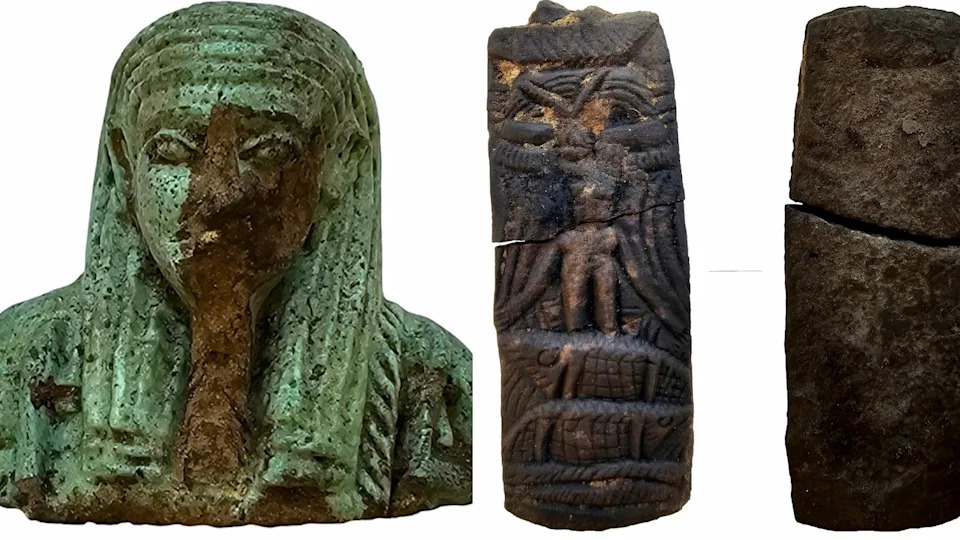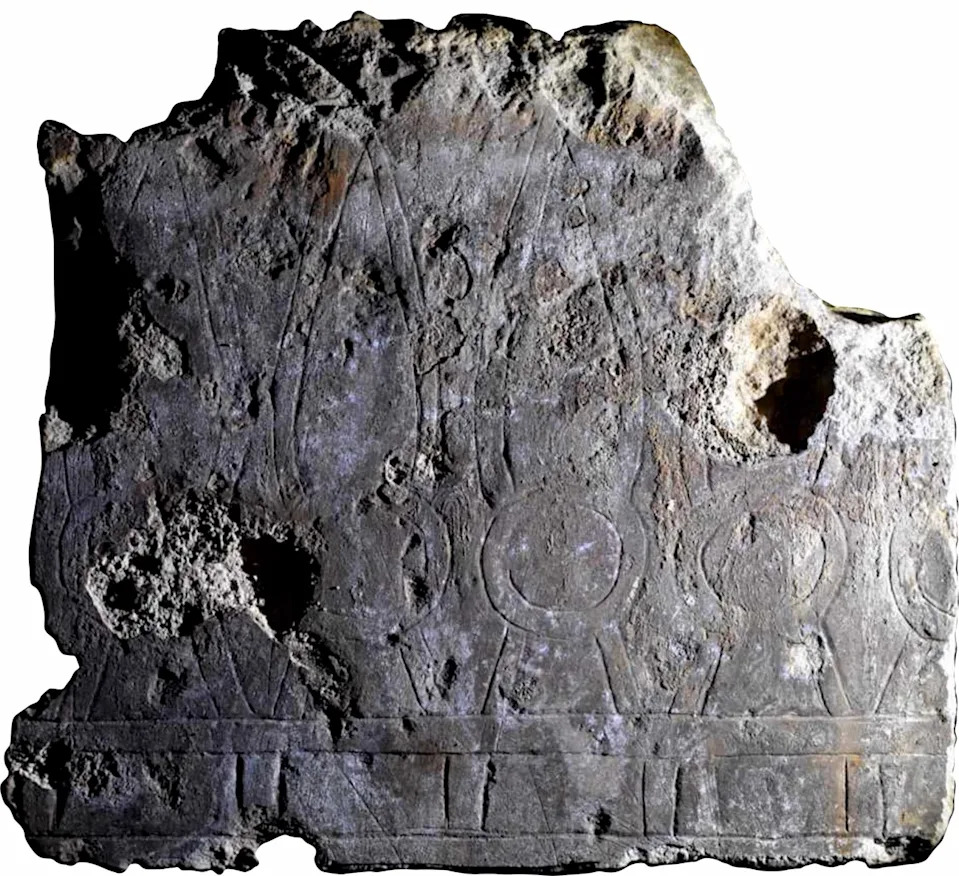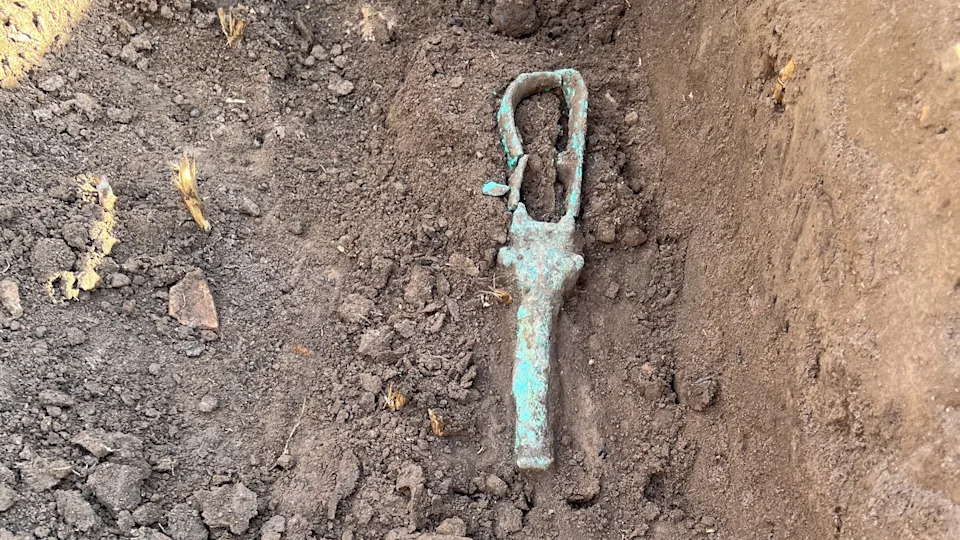'Thriving and densely-built': Archaeologists unearth 'tower' houses and ceremonial building in ancient Egyptian city of Imet
When you buy through links on our articles, Future and its syndication partners may earn a commission.
 Researchers discovered the remains of ancient Egyptian buildings and artifacts, including a green faience (glazed ceramic) figurine and a stele. | Credit: University of Manchester
Researchers discovered the remains of ancient Egyptian buildings and artifacts, including a green faience (glazed ceramic) figurine and a stele. | Credit: University of ManchesterArchaeologists have discovered the remains of multistory houses and a ceremonial building linked to the cobra-headed goddess Wadjet in the ancient Egyptian city of Imet.
Dense architectural remains indicate that Imet was a bustling urban center during Egypt's Late Period (circa 664 to 332 B.C.), or the last period of Egyptian rule before Alexander the Great and his general Ptolemy I Soter took over, according to a statement describing recent excavations in what is now Tell Nabasha (also spelled Tell Nebesha) — an archaeological site in the eastern Nile Delta.
"Imet is emerging as a key site for rethinking the archaeology of Late Period Egypt," Nicky Nielsen, a senior lecturer in Egyptology at the University of Manchester in the U.K. who directed the excavations, said in the statement.
The newly discovered multistory houses, or tower houses, were likely designed to accommodate a growing population in what was a prominent city in ancient times, particularly in the fourth century B.C., Nielsen said.
"These tower houses are mainly found in the Nile Delta between the Late Period and the Roman era, and are rare elsewhere in Egypt," he said. "Their presence here shows that Imet was a thriving and densely-built city with a complex urban infrastructure."
Nielsen and his team first spotted the tower-house remains on high-resolution satellite images, which revealed clusters of ancient mudbrick in Imet. The researchers traveled to the ancient city to excavate these structures, as well as the ruins of a paved area for grain processing and animal enclosures, which together point to an active local economy, according to the statement.
Related: 'Major' ancient Egyptian town discovered — and it has a jug stamped with the name of Nefertiti's daughter
 A stone relief from the ancient Egyptian city of Imet. | Credit: University of Manchester
A stone relief from the ancient Egyptian city of Imet. | Credit: University of ManchesterTogether with Egyptian archaeologists, the researchers also unearthed a large building with a limestone plaster floor and huge pillars dating to the Ptolemaic period (332 to 30 B.C.), when Ptolemy I Soter's dynasty ruled Egypt. The building sits on the ancient processional road to the temple of Wadjet — the patron goddess and protector of Lower Egypt, traditionally depicted as a winged cobra or as a woman with the head of a cobra — suggesting the building itself also held spiritual significance.
 Archaeologists unearthed a sistrum, which is a hand-held percussion instrument similar to a rattle used in ancient Egypt. | Credit: University of Manchester
Archaeologists unearthed a sistrum, which is a hand-held percussion instrument similar to a rattle used in ancient Egypt. | Credit: University of ManchesterEvidence suggests the processional road fell out of use in the mid-Ptolemaic period, indicating a shift in religious culture, according to the statement.
RELATED STORIES
—Ancient Egyptian city of Alexandria — the birthplace of Cleopatra — is crumbling into the sea at an unprecedented rate
—Archaeologists unearth tree-lined walkway that led to ancient Egyptian fortress in Sinai Desert
—2,100-year-old temple from ancient Egypt discovered hidden in cliff face
In the ruins of buildings, the researchers found various stunning artifacts, including a green faience ushabti — or glazed ceramic funerary figurine — from the 26th dynasty (Late Period), a stone slab with engravings of the god Harpocrates and protective symbols and a musical instrument featuring the goddess of music and joy, Hathor.
The discovery of complex infrastructure and ancient religious artifacts from Imet "opens new doors to our understanding of daily life, spirituality and urban planning in the Delta," Nielsen said.
Ancient Egypt quiz: Test your smarts about pyramids, hieroglyphs and King Tut
The recent archaeological finds in the ancient Egyptian city of Imet reveal thriving and densely-built 'tower' houses alongside ceremonial structures, offering a rare glimpse into how life was structured during that bygone era.
Exciting discovery of ancient 'tower' houses and a ceremonial building in Imet demonstrates the thriving density that flourished during this period, providing valuable insights into daily life as well cultural practices within early Egyptian society.
The exciting discovery of 'thriving and densely-built' tower houses along with ceremonial structures in the ancient Egyptian city Imet unearthed by archaeologists sheds new light on urban planning, social organization as well a prehistoric form compelling us to reimagine everyday life back then.
The excavation of ancient Egyptian Imet reveals remarkably 'thriving and densely-built' tower houses alongside significant ceremonial structures, offering a unique glimpse into the city’s twin facets: domestic life amidst elaborate ritual practices.














